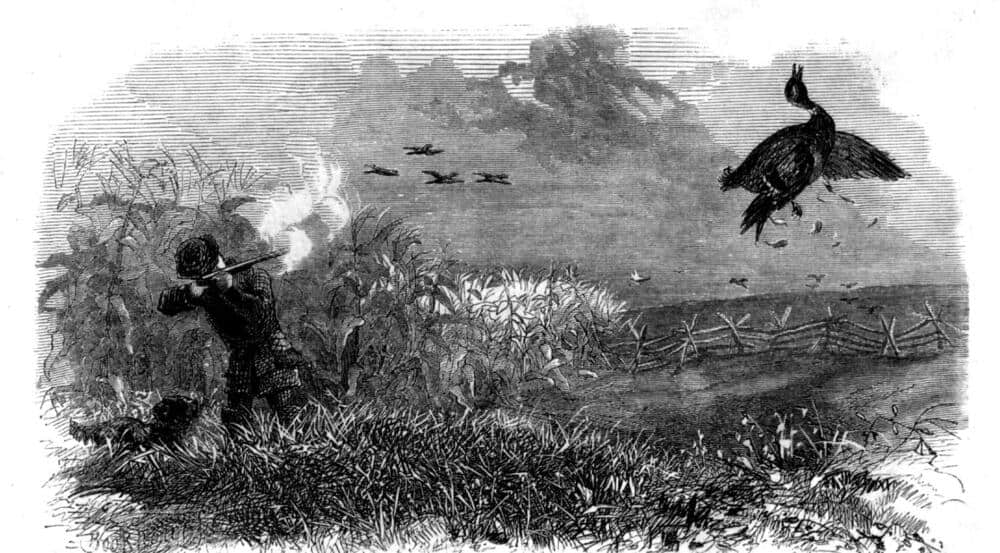Sporting Life

The Simple, Yet Complex, Shotgun
By Dennis Doyle
Fetching my two bird guns from their armored safe for the season, I once again marveled at how much affection emanated from my old bones toward their low-light glow.
My favorite 16-gauge doubles weren’t new when I first obtained them long ago in my sporting youth but by now they are over 100 years old and still do the job they were originally designed to do, not just adequately but magnificently.
These two pieces were designed in the early 1900s by an engineer/inventor in Baltimore, Ansley H. Fox, and manufactured in Philadelphia. The shotguns he produced were among the finest of their time in America. Teddy Roosevelt shot them and pronounced them the best in the world. The field models sold for about $50 and many thousands of them were bought and used throughout the U.S. as were similar guns by American makers Parker Bros, Ithaca Arms, Winchester, L.C. Smith, Remington and Savage.
The shotgun, a smooth bore firearm, is designed to throw a quantity of small, spherical shot, generally at flying or rapidly moving targets. It’s been around in multiple forms for more than three centuries. But in these days of urban living they are somewhat of a mystery to many who are unfamiliar with firearms of any kind.
The shotgun firearm itself is available in a wide variety of individual models. There are the doubles, which possess two barrels, some in a side-by-side arrangement and others with one barrel over the other (an over/under). There are also single shot, single barrel shotguns, pump or slide action guns and semi-automatic action repeating guns holding five or more shots in their magazines.
Additionally they are specifically identified by gauge, an arcane British measurement that specifies the barrel’s diameter by the count of the lead balls that would fit in the barrel’s bore totaling one pound of weight. A 16-gauge gun would hold 16 balls of lead, weighing a total of one pound, each with a diameter of .662 inches.
There are five gauges or barrel diameters of shotguns commonly available: the 10-gauge (.775 inches), 12 (.729), 16 (.662), 20 (.615) and the smallest of the shotgun sizes, a .410, which is not technically a gauge but the actual caliber (diameter) of the bore. They all shoot cartridges, which are commonly loaded with a measured quantity of small, spherical birdshot inside them, at velocities usually between 1,000 and 1,250 feet per second. This shot, traditionally, has been lead but due to environmental concerns is now available in steel and other non-toxic materials.
The shot pellet size is indicated by another identification number from the #00 at .33-inch diameter down to #9 at .08 of an inch. The larger shot sizes are for larger game with the #00 typically used for deer and wild boar-sized game, the middle sizes #2 through #4 for pheasant and waterfowl such as goose and duck, and sizes #6 thru #8 for small game such as rabbit, squirrel, grouse, partridge and clay target shooting.
A 10-gauge cartridge (the largest) can hold up to 2 ounces of shot, a 12-gauge as much as 1½ ounce, the 16 about 1¼ and 1 1/8 for the 20-gauge. The .410 shotgun shell holds half an ounce of shot. Standard cartridges are 2¾ inches long, the .410 at 2½, though there are also magnum versions at 3 inches, holding heavier payloads.
It’s difficult to imagine a wood and steel creation of so many variables evoking any kind of emotion in a person but after cradling them in my arms so many hundreds of hours and collecting countless meals and adventurous moments in a lifetime of ranging afield it is impossible not to become bonded to them to some degree. They call wing-shooting an art and to me it certainly is, with the bird gun being my instrument for creating timeless memories of intensity and excitement.
*****
Fishfinder:
Rockfish season ends December 10, better get ’em while you can!
